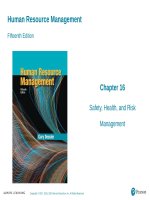Human resource management 8e by gomez mejia 2016 chapter 17
Bạn đang xem bản rút gọn của tài liệu. Xem và tải ngay bản đầy đủ của tài liệu tại đây (2.11 MB, 22 trang )
Chapter 17
International HRM Challenge
Copyright © 2016 Pearson Education, Inc.
17-1
Chapter Challenges
1.
2.
3.
Specify the HRM strategies that are most appropriate for firms at
different stages of internationalization
Identify the best mix of host-country and expatriate employees given
the conditions facing a firm
Explain the challenges of expatriate assignments
Copyright © 2016 Pearson Education, Inc.
17-2
Chapter Challenges
4.
5.
6.
Learn how to effectively manage expatriate assignments and minimize
the chances of failure
Develop HRM policies and procedures that match the needs and values
of different cultures
Consider ethical implications of HRM policies and procedures on a global
basis
Copyright © 2016 Pearson Education, Inc.
17-3
International Involvement
•
•
•
Expatriate
Multinational Corporation (MNC)
Transnational Corporation
Copyright © 2016 Pearson Education, Inc.
17-4
The Stages of International Involvement
Copyright © 2016 Pearson Education, Inc.
17-5
International Involvement
•
•
•
•
Outsourcing
Falling Barriers
Small- and Medium-Size Enterprises Going Global
The Global Manager
Copyright © 2016 Pearson Education, Inc.
17-6
Determining the Mix
Host-Country and Expatriates
•
•
•
•
•
Wholly owned subsidiaries
Joint venture
Ethnocentric approach
Polycentric approach
Geocentric approach
Copyright © 2016 Pearson Education, Inc.
17-7
Advantages and Disadvantages
Copyright © 2016 Pearson Education, Inc.
17-8
Reliance on Expatriates
Increases When:
•
•
•
•
Local talent is not available
Overall business strategy is global vision
International units and domestic operations are highly interdependent
Technology has reduced need for expatriate to link the international units to home
office
•
•
The political situation is unstable
Significant cultural differences exist between host and home countries
Copyright © 2016 Pearson Education, Inc.
17-9
The Challenges of Expatriate Assignments
Why International Assignments Fail
Career blockage
Culture shock
Lack of pre-departure cross-cultural training
Overemphasis on technical qualifications
Troublesome employees
Family problems
•
•
•
•
•
•
Copyright © 2016 Pearson Education, Inc.
17-10
The Challenges of Expatriate Assignments
Difficulties on Return
Lack of respect for acquired skills
Loss of status
Poor planning for return position
Reverse culture shock
•
•
•
•
Copyright © 2016 Pearson Education, Inc.
17-11
Using HRM to Effectively Manage Expatriates
Selection
•
•
•
•
•
•
•
Emphasize cultural sensitivity as a selection criterion
Establish a selection board of expatriates
Require previous international experience
Explore the possibility of hiring foreign-born employees
Carefully consider expatriate’s ethical values
Screen candidate’s spouses and families
Develop an effective selection program
Copyright © 2016 Pearson Education, Inc.
17-12
Training
•
•
•
•
Cross-cultural training
9 to 12 months before the assignment
Expatriate family training
Approaches to training
Information-giving approach
Affective approach
Impression approach
o
o
o
Copyright © 2016 Pearson Education, Inc.
17-13
Career Development
Important Guidelines:
Position the international assignment as a step toward
advancement
Provide support for the expatriate
Provide support for the spouse
•
•
•
Copyright © 2016 Pearson Education, Inc.
17-14
Compensation
Important Guidelines:
Provide the expatriate with disposable income equivalent to home
disposable income
Provide explicit “add-on” incentive for accepting international assignment
Avoid having expatriate fill the same jobs held by locals or lower-ranking
jobs
•
•
•
Copyright © 2016 Pearson Education, Inc.
17-15
Using HRM to Effectively
Manage Expatriates
Role of HR Department
Women and International Assignments
Copyright © 2016 Pearson Education, Inc.
17-16
Hofstede’s Five Cultural Dimensions
Power Distance
Individualism
Uncertainty Avoidance
Masculinity/Femininity
Orientation
Copyright © 2016 Pearson Education, Inc.
17-17
EEO in the International Context
Prohibition of basing employment decisions race, sex, and age
Foreign-national employees are not covered by U.S. law
Immigration Control and Reform Act of 1986
Copyright © 2016 Pearson Education, Inc.
17-18
Important Caveats
•
•
•
•
•
•
•
National culture may be an elusive concept
Cultures change over time
Blame is sometimes placed on cultural factors
Hard data are not present
Right and wrong values vary
Business laws vary
The need to find the right balance of HRM policies
Copyright © 2016 Pearson Education, Inc.
17-19
HRM and Exporting Firms
•
•
•
HRM Practices for International Activity
Ethics and Social Responsibility
Dealing with Political Risks
Copyright © 2016 Pearson Education, Inc.
17-20
Summary and Conclusions
•
•
•
•
The Stages of International Involvement
Determining the Mix of Host-Country and Expatriate Employees
The Challenge of Expatriate Assignments
Effectively Managing Expatriate Assignments with HRM Policies and
Practices
•
•
Developing HRM Policies in a Global Context
Human Resource Management and Exporting Firms
Copyright © 2016 Pearson Education, Inc.
17-21
Pearson Education, Inc.
Copyright
Click to edit Master text styles
Second level
Third level
Fourth level
Fifth level
Copyright © 2016 Pearson Education, Inc.
17-22









